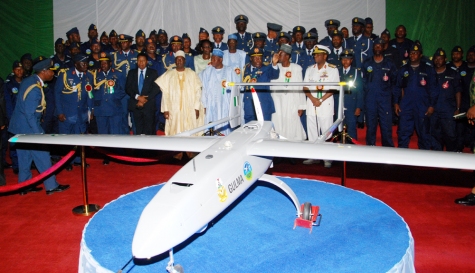
Nigeria Tuesday commissioned its first indigenous unmanned aerial vehicle during a ceremony at the Nigerian Air Force Base in Kaduna.
While commending the military for the feat, President Goodluck Jonathan, who was accompanied by the nation's service chiefs, Governor of Kaduna State, Mr. Muktar Yero, and Information Minister and Supervising Minister of Defence, Mr. Labaran Maku, said the technological breakthrough by the military underscored his administration's commitment to protecting the sovereignty of the nation.
The drone christened GULMA was built by the Nigerian military in collaboration with local institutions. Supervisory Minister of Defence, Labaran Maku, said that the development of the unmanned surveillance aircraft by the Nigerian Air Force at the time the country is battling with terrorism is an indication of the present government's resolve to provide security for the citizens.
He urged other security agencies to incorporate it into their operations to fully harness their potentials. A report on Channels Television website said the 40 kilogramme unmanned aerial vehicle is designed to pick objects 10,000 feet above sea level.
Its history commenced in 2007 when the Nigerian Air Force introduced a 5-year manpower development programme in Aerospace engineering in collaboration with Cranfield University based in the United Kingdom.
The vision was to develop in-house capacity for advanced research and development in the country's aerospace fields. The collaboration between the Nigerian Air Force and the University heralded the design and production of several small unmanned aerial vehicles, which were code named 'Amebo'.
The vehicle, basically made of aluminium alloy structure and operated by radio control only, was designed and tested by the Air Force Institute of Technology (AFIT) in 2009. Besides its diverse military application, the unmanned aircraft provides other benefits; in disaster management, power line surveys, law enforcement, telecommunications, weather monitoring, and aerial imaging and mapping.
It is also rapidly, becoming an important tool in news coverage, environmental monitoring, and oil and gas exploration. From a humble beginning in 2007, the Nigerian Air Force has grown capacity and capability in unmanned aerial vehicle production and operations.
The authorities therefore believe that with adequate funding, this wealth of research could be harnessed to produce various categories of the vehicle to support internal security operations, and also provide civil agencies with aerial surveillance requirements.
No comments:
Post a Comment